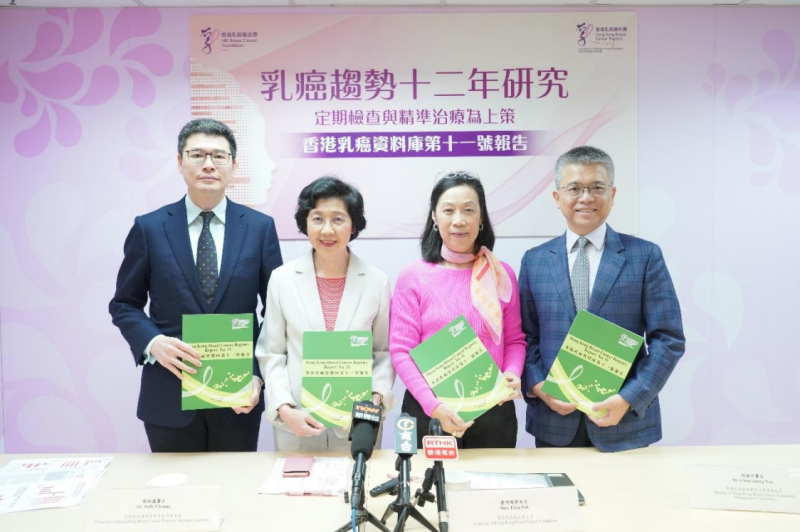 Dr Wai-Ka Hung, Dr Polly Cheung, Ms Eliza Fok, Dr Chun-Chung Yau
Dr Wai-Ka Hung, Dr Polly Cheung, Ms Eliza Fok, Dr Chun-Chung YauBreast cancer screening is underutilized in Hong Kong, with only about 10 percent of cases in 2006–2017 diagnosed through mammography, new data from the Hong Kong Breast Cancer Registry (HKBCR) have shown.
In its 11th annual report, researchers from the HKBCR analyzed data from 18,438 female breast cancer patients diagnosed in Hong Kong between 2006 and 2017. The patients were grouped into four cohorts according to their year of diagnosis (2006–2008, n=3,518; 2009–2011, n=4,931; 2012–2014, n=5,114; 2015–2017, n=3,683).
The analysis showed that 81.4–86.1 percent of breast cancer cases were self-detected by the patients by chance. While the proportion of patients who had ever undertaken mammography screening increased during the study period, a decrease was seen in the proportion of those who undertook mammography on a regular basis.
“Only about 10 percent of local breast cancer cases were diagnosed through mammography screening, even though this modality is proven to be the most effective in detecting asymptomatic breast cancer,” said Dr Wa-Ka Hung, member of HKBCR Management Committee.
In all four study cohorts, most (36.3–39.2 percent) of the breast cancer cases were diagnosed at stage II, with slightly fewer cases (30.8–33.1 percent) being diagnosed at stage I.
In countries where population-wide breast cancer screening is in place, most cases are diagnosed at stage I, the researchers noted.
“In view of these findings, we urge members of the public to undertake mammography screening on a regular basis, and hope that the government can implement population-wide breast cancer screening in Hong Kong,” said Ms Eliza Fok, Chairman of Hong Kong Breast Cancer Foundation (HKBCF).
The report also revealed significant increases in the use of breast-conserving surgery (33.3 percent in 2006–2008, 37.2 percent in 2015–2017) and sentinel node biopsy (46.7 percent in 2006–2008, 75.2 percent in 2015–2017) during the study period.
In terms of systemic treatment, the use of chemotherapy in all settings decreased significantly during the study period. “Significant decreases were found in patients with early-stage breast cancer, as well as those with luminal A or luminal B [HER2-negative] disease,” said Dr Chun-Chung Yau, member of HKBCR Management Committee.
The use of neoadjuvant chemotherapy, however, saw an overall increase, from 4.9 percent in 2006–2008 to 14.2 percent in 2015–2017 (p<0.05). The largest increases were seen among patients with HER2-positive disease (from 8 percent in 2006–2008 to 18.4 percent in 2015–2017) and triple-negative disease (from 4.8 percent to 19.7 percent).
“In patients with HER2-postive or triple-negative breast cancer, neoadjuvant chemotherapy has been associated with pathological complete response rates of 30–50 percent,” noted Yau.
Although the overall use of radiotherapy did not change significantly during the study period, significant decreases were seen among patients with stage I (from 13 percent in 2006–2008 to 8.8 percent in 2015–2017) or stage IIA disease (from 40 percent to 32.2 percent), while a significant increase was seen in those with stage IIB disease (from 76.2 percent to 82.8 percent).